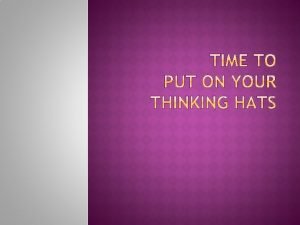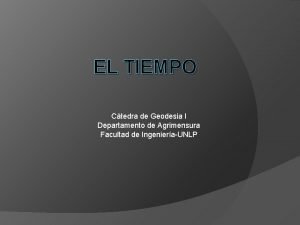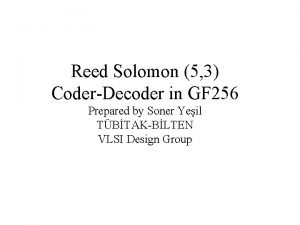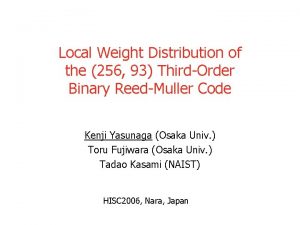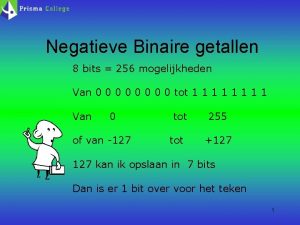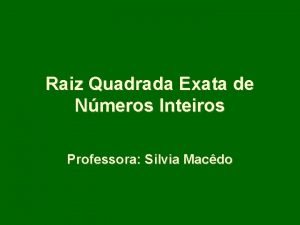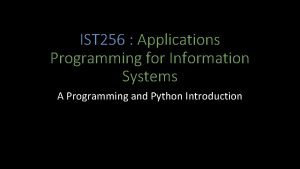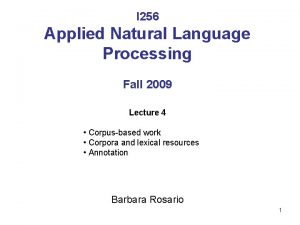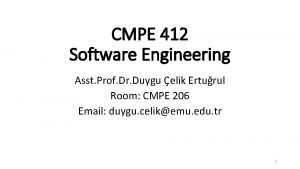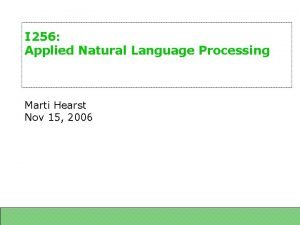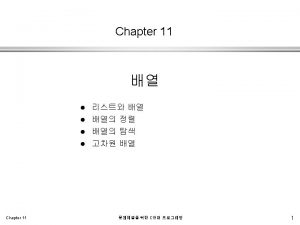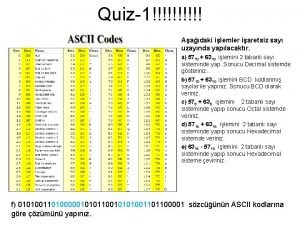1 p 256 O quiz0 1 printfd quiz1





![1차원 배열 원소 참조 p. 256 O 예) § quiz[0] = 1; § printf("%d", 1차원 배열 원소 참조 p. 256 O 예) § quiz[0] = 1; § printf("%d",](https://slidetodoc.com/presentation_image/56c7886e2e507224899e94060ed3a7ce/image-6.jpg)





















![버블 정렬: [프로그램 7 -4]의 개선 repeat가 repeat가 1 2 3 4 → → 버블 정렬: [프로그램 7 -4]의 개선 repeat가 repeat가 1 2 3 4 → →](https://slidetodoc.com/presentation_image/56c7886e2e507224899e94060ed3a7ce/image-28.jpg)












































- Slides: 72





![1차원 배열 원소 참조 p 256 O 예 quiz0 1 printfd 1차원 배열 원소 참조 p. 256 O 예) § quiz[0] = 1; § printf("%d",](https://slidetodoc.com/presentation_image/56c7886e2e507224899e94060ed3a7ce/image-6.jpg)
1차원 배열 원소 참조 p. 256 O 예) § quiz[0] = 1; § printf("%d", quiz[1]); § scanf("%d", &quiz[0]); § quiz[4]++; 6








Program 7 -2 배열의 최솟값 구하기 p. 262 2 #define N 5 3 4 int main() 5 { 6 int f[N] = {3, 0, -30, -20, -1}; // 배열 선언 7 int i, min; 8 9 // 최솟값 구하기 10 min = f[0]; 11 for (i=1; i<N; i++) 12 { 13 if (f[i] < min) 14 min = f[i]; 15 } 16 18 printf("어는 점 목록: "); 19 for (i=0; i<N; i++) 20 printf("%4 d", f[i]); 21 23 printf("n가장 낮은 어는 점: %d n", min); 14












Program 7 -4 가장 단순한 버블 정렬 p. 267 2 #define SIZE 5 3 4 int main() 5 { 6 int i, repeat, temp, a[SIZE] = {5, 4, 3, 2, 1}; 7 9 for (repeat=1; repeat<SIZE; repeat++) //(배열 원소수-1)번 반 복 10 11 12 13 15 16 17 18 19 20 21 22 { // 두 원소간 정렬을 차례대로 반복하기 for (i=0; i<SIZE-1; i++) { if (a[i] > a[i+1]) { temp = a[i]; a[i] = a[i+1]; a[i+1] = temp; } } } // 바깥 for 끝 26

![버블 정렬 프로그램 7 4의 개선 repeat가 repeat가 1 2 3 4 버블 정렬: [프로그램 7 -4]의 개선 repeat가 repeat가 1 2 3 4 → →](https://slidetodoc.com/presentation_image/56c7886e2e507224899e94060ed3a7ce/image-28.jpg)
버블 정렬: [프로그램 7 -4]의 개선 repeat가 repeat가 1 2 3 4 → → p. 268 (a[0], a[1]), (a[1], a[2]), (a[2], a[3]), (a[3], a[4]) (a[0], a[1]), (a[1], a[2]), (a[2], a[3]) (a[0], a[1]), (a[1], a[2]) (a[0], a[1]) → → i가 i가 0 0 ~ ~ 3까지 a[i]와 a[i+1] 비교 2까지 “ 1까지 “ 0까지 “ 14 for (repeat=1; repeat<SIZE; repeat++) 15 { 16 for (i=0; i<SIZE-repeat; i++) 17 { 18 if (a[i] > a[i+1]) : 28

Program 7 -5 정렬이 완료된 원소 간 비교를 제거 p. 269 2 #define SIZE 5 3 4 int main() 5 { 6 int i, repeat, temp, a[SIZE] = {5, 4, 3, 2, 1}; 7 13 // 버블 정렬 시작 14 for (repeat=1; repeat<SIZE; repeat++) 15 { 16 for (i=0; i<SIZE-repeat; i++) 17 { 18 if (a[i] > a[i+1]) 19 { 20 temp = a[i]; 21 a[i] = a[i+1]; 22 a[i+1] = temp; 23 } 24 } 25 } 29




























Program 7 -8 학생의 정보를 문자열로 입력받아 출력하기 p. 286 1 #include <stdio. h> 3 int main() 4 { 5 char university[11], std_no[9], name[10]; 6 int i, j; // 문자열 저장 배열 7 9 printf("학교명은? "); scanf("%s", university); 11 printf("학번은? "); 13 fflush(stdin); 14 printf("이름은? "); 15 gets(name); scanf("%s", std_no); //std_no 입력후 남은 엔터키가 15행에서 사용되는 것을 방지 // 빈 칸 포함 이름 입력받도록 gets 이용 16 17 printf("=============n"); 18 printf("%s %c%c학번 %s n", 19 20 university, std_no[2], std_no[3], name); printf("=============n"); 57










Program 7 -10 3차원 배열의 출력 p. 291 2 #define L 2 // 면 개수 3 #define M 3 // 행 개수 4 #define N 4 // 열 개수 5 6 int main() 7 { 8 int n[L][M][N] = {{{20, 22, 30, 35}, {12, 19, 35, 22}, {10, 9, 15, 20}}, 9 {{20, 22, 30, 35}, {12, 19, 35, 22}, {12, 15, 9, 25}}}; 10 int i, j, k; 11 12 for (i=0; i<L; i++) // 면 개수만큼 반복 13 { 14 printf("n %d면 nn", i+1); 15 for (j=0; j<M; j++) // 행 개수만큼 반복 16 { 17 for (k=0; k<N; k++) // 열 개수만큼 반복 18 printf("%3 d ", n[i][j][k]); 19 printf("n"); 20 } 21 } 67





 Quiz0
Quiz0 Printfd
Printfd Printf
Printf 128+64+16+1
128+64+16+1 El año sideral dura 365. 256 días solares medios
El año sideral dura 365. 256 días solares medios All perfect square numbers
All perfect square numbers 2^x=256
2^x=256 Sha 256
Sha 256 Gf(256)
Gf(256) 256+93
256+93 Vlookup reference error 256 columns
Vlookup reference error 256 columns There is no compulsion in religion
There is no compulsion in religion Alas sebuah limas berbentuk persegi dengan luas 256
Alas sebuah limas berbentuk persegi dengan luas 256 8 bit 256
8 bit 256 Raiz quadrada de 512
Raiz quadrada de 512 Ist 256
Ist 256 I^256
I^256 374 onluğa yuvarlama
374 onluğa yuvarlama Cmpe 256
Cmpe 256 Manifestversion
Manifestversion Resolución 256 de 2018
Resolución 256 de 2018 I^256
I^256


